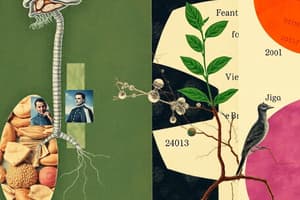Podcast
Questions and Answers
What characteristic defines autotrophs?
What characteristic defines autotrophs?
- They produce their own food using light or chemical energy. (correct)
- They are unable to perform photosynthesis.
- They derive energy by consuming other organisms.
- They require organic compounds for growth.
Which of the following statements is true regarding prokaryotic cells?
Which of the following statements is true regarding prokaryotic cells?
- They are generally unicellular organisms. (correct)
- Their DNA is organized within a nucleus.
- They can only exist in anaerobic environments.
- They have membrane-bound organelles.
Which of these factors are considered abiotic?
Which of these factors are considered abiotic?
- Fungi and phytoplankton.
- Bacteria and fungi.
- Plants and animals.
- Sunlight and temperature. (correct)
Heterotrophs are primarily characterized by which of the following?
Heterotrophs are primarily characterized by which of the following?
What distinguishes eukaryotic cells from prokaryotic cells?
What distinguishes eukaryotic cells from prokaryotic cells?
Flashcards are hidden until you start studying
Study Notes
Autotrophs
- Autotrophs are organisms that produce their own food using light (photosynthesis) or chemical energy (chemosynthesis).
- They play a critical role in ecosystems as primary producers, forming the base of the food chain.
Prokaryotic Cells
- Prokaryotic cells lack a nucleus and membrane-bound organelles, differentiating them from eukaryotic cells.
- Their DNA is typically circular and located in a region called the nucleoid.
- Prokaryotes include bacteria and archaea, known for their simple cell structure.
Abiotic Factors
- Abiotic factors are non-living components that affect the environment and ecosystems.
- Examples include sunlight, temperature, water, soil, and minerals.
- These factors influence the health and distribution of living organisms.
Heterotrophs
- Heterotrophs are organisms that cannot produce their own food and depend on consuming other organisms.
- They include animals, fungi, and many bacteria, playing a vital role in nutrient cycling and energy transfer within ecosystems.
Eukaryotic vs. Prokaryotic Cells
- Eukaryotic cells possess a true nucleus containing their DNA, unlike prokaryotic cells.
- They contain various membrane-bound organelles (e.g., mitochondria, endoplasmic reticulum) that perform specialized functions.
- Eukaryotes include organisms such as plants, animals, fungi, and protists, exhibiting greater complexity in structure and function.
Studying That Suits You
Use AI to generate personalized quizzes and flashcards to suit your learning preferences.



